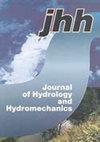The testing of a multivariate probabilistic framework for reservoir safety evaluation and flood risks assessment in Slovakia: A study on the Parná and Belá Rivers
IF 2.4
4区 环境科学与生态学
Q3 WATER RESOURCES
引用次数: 0
Abstract
Abstract Intense floods represent a challenge to risk management. While they are multivariate in their nature, they are often studied in practice from univariate perspectives. Classical frequency analyses, which establish a relation between the peak flow or volume and the frequency of exceedance, may lead to improper risk estimations and mitigations. Therefore, it is necessary to study floods as multivariate stochastic events having mutually correlated characteristics, such as peak flood flow, corresponding volume and duration. The joint distribution properties of these characteristics play an important role in the assessment of flood risk and reservoir safety evaluation. In addition, the study of flood hydrographs is useful because of the inherent dependencies among their practice-relevant characteristics present on-site and in the regional records. This study aims to provide risk analysts with a consistent multivariate probabilistic framework using a copula-based approach. The framework respects and describes the dependence structures among the flood peaks, volumes, and durations of observed and synthetic control flood hydrographs. The seasonality of flood generation is respected by separate analyses of floods in the summer and winter seasons. A control flood hydrograph is understood as a theoretical/synthetic discharge hydrograph, which is determined by the flood peak with the chosen probability of exceedance, the corresponding volume, and the time duration with the corresponding probability. The framework comprises five steps: 1. Separation of the observed hydrographs, 2. Analysis of the flood characteristics and their dependence, 3. Modelling the marginal distributions, 4. A copula-based approach for modelling joint distributions of the flood peaks, volumes and durations, 5. Construction of synthetic flood hydrographs. The flood risk assessment and reservoir safety evaluation are described by hydrograph analyses and the conditional joint probabilities of the exceedance of the flood volume and duration conditioned on flood peak. The proposed multivariate probabilistic framework was tested and demonstrated based on data from two contrasting catchments in Slovakia. Based on the findings, the study affirms that the trivariate copula-based approach is a practical option for assessing flood risks and for reservoir safety.斯洛伐克水库安全评价和洪水风险评估的多元概率框架的检验:以帕纳河和贝尔河为例
特大洪水对风险管理提出了挑战。虽然它们本质上是多元的,但在实践中往往从单变量的角度来研究它们。经典的频率分析建立了峰值流量或容量与超限频率之间的关系,可能导致不适当的风险估计和减轻。因此,有必要将洪水作为具有洪峰流量、相应体积和持续时间等相互关联特征的多变量随机事件进行研究。这些特征的联合分布特性在洪水风险评价和水库安全评价中具有重要作用。此外,洪水线的研究是有用的,因为它们在现场和区域记录中与实践相关的特征之间存在固有的依赖性。本研究的目的是为风险分析师提供一个一致的多元概率框架,使用基于copula的方法。该框架尊重并描述了观测到的和合成控制洪水线的洪峰、体积和持续时间之间的依赖结构。通过对夏季和冬季洪水的单独分析,尊重洪水产生的季节性。控制洪水线被理解为理论/合成流量线,它由选定的超过概率的洪峰、相应的水量和相应概率的持续时间确定。该框架包括五个步骤:1。2.分离观测到的水线;2 .洪水特征及其相关性分析;4.对边际分布进行建模。基于copula的洪水峰值、体积和持续时间联合分布建模方法,5。合成洪水线的建设。通过水文曲线分析和以洪峰为条件的超过洪量和持续时间的条件联合概率来描述洪水风险评价和水库安全评价。根据斯洛伐克两个不同流域的数据,对提出的多变量概率框架进行了测试和论证。研究结果表明,基于三元copula的方法是评估洪水风险和水库安全的实用选择。
本文章由计算机程序翻译,如有差异,请以英文原文为准。
求助全文
约1分钟内获得全文
求助全文
来源期刊
CiteScore
4.20
自引率
5.30%
发文量
30
审稿时长
>12 weeks
期刊介绍:
JOURNAL OF HYDROLOGY AND HYDROMECHANICS is an international open access journal for the basic disciplines of water sciences. The scope of hydrology is limited to biohydrology, catchment hydrology and vadose zone hydrology, primarily of temperate zone. The hydromechanics covers theoretical, experimental and computational hydraulics and fluid mechanics in various fields, two- and multiphase flows, including non-Newtonian flow, and new frontiers in hydraulics. The journal is published quarterly in English. The types of contribution include: research and review articles, short communications and technical notes. The articles have been thoroughly peer reviewed by international specialists and promoted to researchers working in the same field.

 求助内容:
求助内容: 应助结果提醒方式:
应助结果提醒方式:


